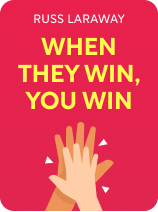

This article is an excerpt from the Shortform book guide to "When They Win, You Win" by Russ Laraway. Shortform has the world's best summaries and analyses of books you should be reading.
Like this article? Sign up for a free trial here.
What are Objectives and Key Results (OKRs)? How do they contribute to an organization’s mission?
Employee experience expert Russ Laraway says that the first area of focus for an effective manager is setting clear goals for employees: Your workers should know exactly what’s expected of them and when. He lays out four tiers of goals that managers can set for their employees. The second tier is OKRs.
Read more to learn what OKRs are and how they fit into the overall goals of an organization.
Objectives and Key Results
Laraway divides goals into four tiers, starting with shorter-term goals and culminating in the company’s long-term goal. Each tier supports the one above it. The foundational tier of goals is what Laraway calls priorities—what workers get done daily or weekly. The second tier is what Laraway terms Objectives and Key Results. The third tier is what Laraway calls the company’s vision—the specific thing it’s trying to achieve. Finally, the highest tier of goals is the company’s ultimate aspiration, which Laraway calls its purpose or mission—in other words, the reason the company exists in the first place.
Let’s zoom in on the second tier: Objectives and Key Results (OKRs). So, what are Objectives and Key Results? This is what a person or team achieves in a somewhat longer timeframe: monthly, quarterly, or yearly. For many employees, an OKR may just be an extension of a daily or weekly goal. For instance, if their daily goal is to process a certain number of insurance claims, then their monthly goal might be to process that number of claims on average each day for a month.
(Shortform note: OKR is a common term in business, with a history dating back to the 1960s. As John Doerr explains in Measure What Matters, many large corporations, including Google, credit their success to the effective use of OKRs because this system makes it easier to break large, ambitious goals (such as multiyear or yearly goals) into manageable, measurable goals (such as daily, weekly, or monthly ones).)
Note that this tier of goal has two elements: OKRs comprise Objectives (what you want to achieve during this timeframe) and Key Results (how, specifically, you will achieve it). In other words, think of the results as smaller, measurable goals that build up to the larger objective. For example, maintaining an average number of claims processed each day might be an objective, while the number of claims that employee processes each day is the key result.
Laraway adds that each objective at this level should connect to the company’s ultimate aspiration (why you’re doing it). All of your workers should clearly understand how their work supports the company. For the claims processor from the previous examples, this might be as simple as understanding that their work supports the company’s mission of, say, helping people navigate the healthcare system.
| Digging Deeper Into What, How, and Why In First Things First, Stephen Covey echoes this “what, how, and why” approach to setting goals, but he adds a couple of details that Laraway doesn’t discuss. Note that Covey talks about setting personal goals, but you can adapt his principles to work in a business setting. First, in deciding what goal to pursue, Covey says that you should make sure it’s challenging, yet realistic. Challenging goals keep your employees from getting bored, but goals that are too challenging may cause them to become frustrated. When discussing the “how,” Covey doesn’t just mean the steps you’ll take to achieve your goal, but also how you’ll keep yourself motivated and on task. Think of this as going one step further: asking how you’ll accomplish the “how.” This is also a useful question to ask struggling workers—how might they keep themselves motivated and focused at work? How could you (as their manager) help them do so? Finally, Covey says to make sure that your “why” is meaningful to you (or in this case, the company) and not based on what other people want or expect from you. As a manager, you might ask your workers whether it’s clear how their OKRs support the company’s overall goals; if it’s not clear, try to clarify for them. If it turns out the OKRs don’t support the company’s overall goals, then you may need to set different OKRs. For example, Wizards of the Coast (the company behind Dungeons & Dragons) tried to update its licensing agreements in a way that would be more profitable for itself. In doing so, it faced enormous backlash and boycotts; people accused the company of chasing profits for shareholders and executives and losing sight of its mission to “inspire a lifetime love of games.” In other words, the “why” behind the license updates didn’t serve the company’s goals—if asked, the employees responsible for making those updates might have been able to point out that they weren’t likely to inspire a love of gaming in customers. |

———End of Preview———
Like what you just read? Read the rest of the world's best book summary and analysis of Russ Laraway's "When They Win, You Win" at Shortform.
Here's what you'll find in our full When They Win, You Win summary:
- Why managers are to blame for employees' lack of engagement
- How to improve your team's morale and performance
- Tools for gauging your effectiveness as a manager






